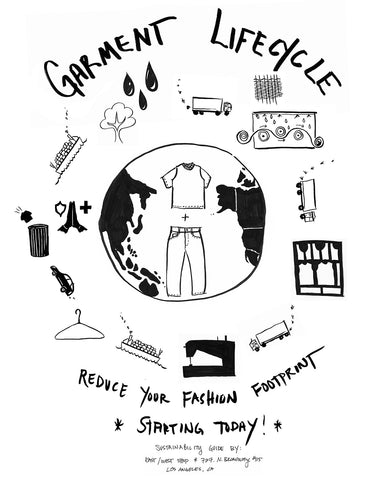Sustainability, Circular Fashion + The Garment Lifecycle

Earth Day - April 22, 2021
Our shop's mission from the day we started was to try and figure out how we could work more sustainably in the fashion industry. Some days this seems like a huge task - and it's become more and more clear that it's a complex one. But our focus has always been on what WE can do. We figure if we start to make changes and question wasteful practices that have become "normal" - then we could start making changes in our own lives immediately. We figured that if we started to make changes then we would inspire other people to do it as well and it would have an immediate impact on our local environment... and we were right!
In the past (almost) 6 years since we opened the shop- many of the words that we had to define and explain are now known (vintage, deadstock, overstock, surplus, upcycled). New terms have emerged to explain what we stand for (intersectional environmentalism) and the world is continually shifting and new language being born. When we say the words "Sustainable Fashion" they now come loaded with a pretense of a solution to a problem that is much bigger than just finding a sustainable way for people to produce.
Along the way I have been challenged with many people claiming "sustainable" practices. Sometimes those practices are only one small part of the garment's construction and only a small step toward true sustainability. (Although everyone get's credit for trying... there is a difference in using sustainability as a marketing ploy vs. actually trying to do better). Since then the term Greenwashing has popularized to explain this further. More resources on that below...
And so from that I created this illustration to show the lifecycle of a garment. We use this lifecycle to think about the entire cycle of each garment and how we can use the Earth's resources in the best ways possible. We know we will most likely not be perfect - especially without money and resources - it's hard to compete against businesses doing nothing. But we think of each stage of garment creation of a spectrum. There is always an option a little better than what you are currently doing - and there is one that is the best possible. We always strive for the best possible solution and know that sometimes we will just do our best.
Chances are if you've stopped into our shop before and mentioned this lifecycle (it currently lives printed on a curtain towards the back of the shop) you've heard all of the information below. But for all of you who don't get the pleasure of stopping in I've written it all out below for you. I hope it gives you an idea of what goes into making your clothes and inspires your future buying choices!
- Erin Han
Read on for an explanation of the cycle...

Raw materials require the Earth's resources plain and simple. And each raw material has it's own footprint.
Cotton is an important crop that is easy to grow and makes farmers money globally. It provides the livlihoods for approximately 100 million farmers worldwide. Cotton comes from the Earth and will biodegrade back into the Earth after it's use - and can be grown Organically or Conventionally. Conventional cotton is grown with the help of pesticides and insecticides. In the last few years the use of pesticides in the apparel industry has declined. It currently uses 16% of the world's pesticides (down from 22.5% at it's peak) and 6% of the world's insecticides. Increased demand for Organic cotton may help continue this downward trend. You can read more about cotton growing and clarification on some inaccurate statistics quoted online here.
Polyester is made from oil. Once it's made into a polyester fiber it is essentially plastic. It's non-biodegradeable and every piece of polyester clothing you've ever worn still exists on this planet somewhere. Also the home washing of polyester and other synthetic fibers wash thousands of microplastics into the water system with every wash.
We try to use natural cotton vintage fabrics already created for as many of the items in the shop as possible. Vintage or used fabric that would otherwise be trash is the best - surplus fabric left behind on warehouse shelves in annoying size rolls is next best... and so on and so on.
If we choose a new fabric we try to use the best possible option. And a fiber that regenerates and helps the soil is the top pick. We're especially excited about using Jungmaven hemp blend shirts. Click here to view our current Jungmaven collection.
- Growing hemp has a positive impact on the environment and requires no irrigation, pesticides, synthetic fertilizers or GMO seeds.
- A phytoremediation plant, hemp restores balance to environments by cleaning the soil, air and water.
The truck stands for the transportation... how far do the raw materials have to travel to be turned into fabric?

Textile dyeing and finishing industry is one of the largest polluters. The industry uses more than 8000 chemicals in the process of textile manufacturing.
The World Bank estimates that 17-20% of industrial water pollution comes from textile dyeing and finishing treatment given to fabric.
I have been learning about Natural dyes for over 10 years and have been experimenting and learning about the use of them. it's one of the most exciting things to dye with something that's from the Earth - that is actually good for your health and skin. As our natural dyes break down they release compounds that are actually good for your skin and act as anti-oxidants. But natural dyeing is done very slowly in small batches and hasn't yet become a global fix to the pollution made in this process.
You can see our naturally dyed collection here.
Again, there may be a transportation footprint for the finished fabric... how far away was the fabric made? Was your garment Made in USA with imported fabric?

Approximately 15% of the prepared fabric is lost in the cutting stage. This part blows my mind when I think about all the water, pesticides, dye run off and pollution required to make that fabric!
Our local sewing factory gives the 100% Cotton cutting scrap to a local rag house. Sometime the cutting waste is gathered and recycled into new fabric. The more you support recyclers the more this technology will continue to be funded and evolve! We love the brand Everybody World - making recycled shirts in LA.
Our Scoop Neck Surplus Crop Tees use fabric that uses recycled cotton (also the fabric is also surplus so it's double recycled!)

All sewn clothing is made by humans. The rights of those humans depend on the country and region they are based and the owners of the factory they work for. Make sure you are buying from brands who know their factories.
Most of our garments are sewn in LA by small factories. Los Angeles' minimum wage is $15/hour. Just recently SB-62 (Garment Worker Protection Act) has passed through the 2nd hoop (Senate Judiciary Committee). You can read more about it here and sign a petition in support here.
Every garment is shipped in a polybag (and sometimes also a plastic hanger). Most of those polybags are non-biodegradeable and as a consumer you may never see it.
Most of our product is locally produced and goes straight to our store. We try to reduce and eliminate polybags as much as possible.
When we do use polybags we try to use old stock or purchase biodegradable bags from EcoEnclose.
Some garments never find a new home - and once they've sat around for several years they become Deadstock. This means that they are not used but are vintage or old. You can see our deadstock items here.

Fast fashion has drastically shortened our wear per garment. According to Elizabeth L. Cline, the author of Overdressed: The Shockingly High Cost of Cheap Fashion, we only wear our clothes 7 times on average before discarding them. We find many garments in thrift shops and even in the backend rag market that still have the original tags.
Only approximately 20% of what is donated to our donation shops and resale stores actually sells in the store. The rest goes into a back end market of re-sellers who pull for markets globally. The United States has been shipping our used clothing to Africa for decades. The result has decimated their local textile market and created an import machine that can only be stopped by Americans creating less waste.
The used clothing market is the biggest portion of the future of the apparel industry. It requires more work on everyone's behalf - but the recycling and reuse of pre-existing garments is crucial.
As consumers we choose where to spend our money. Think of every purchase as an investment into something you believe in!
Greenwashing
Today on Earth Day it's important to note that the topic of greenwashing... letting you believe that something you are buying is inherently good when it may not be. While we are not perfect we always do our best and hope to inspire you and ourselves to continue to do better. Today and everyday there will be unhealthy and unsustainable items offered as "earth friendly" or "conscious" or "sustainable". Make sure you know the people you are buying from and think about the entire cycle of the garment... from start to finish to make sure your purchase is really worth it!
Sources/More resources:
Dirty Side of the Garment Industry
Textile Dyeing Industry and Environmental Hazard
Environmental and Social Impacts of Fashion
Guide to Terminology and Greenwashing - Aja Barber
Intersectional Environmentalist Fashion Resource Guide
Print and Share the coloring page below here FREE!










